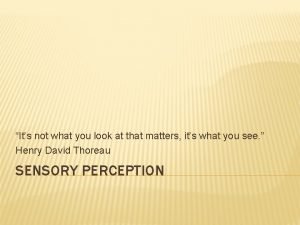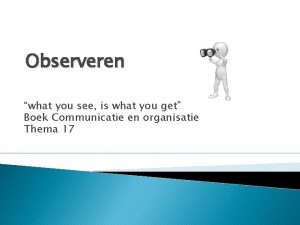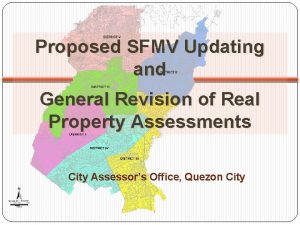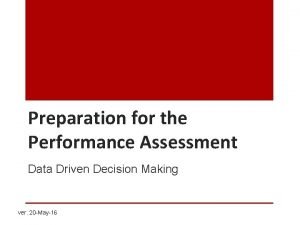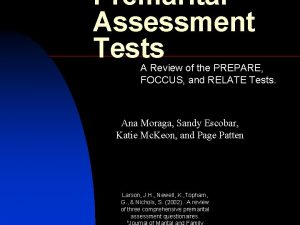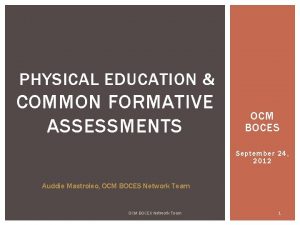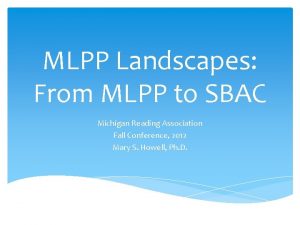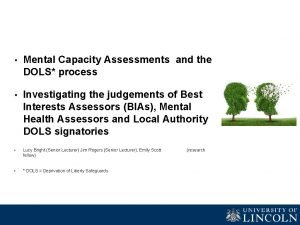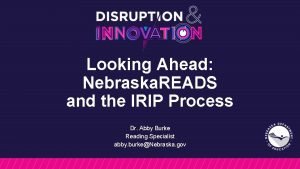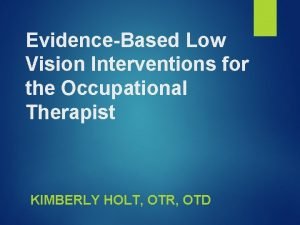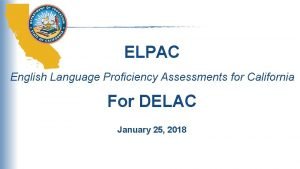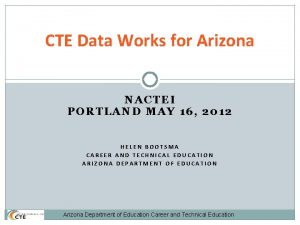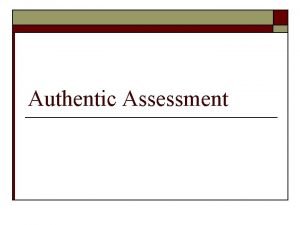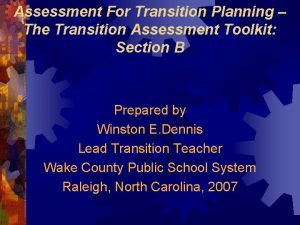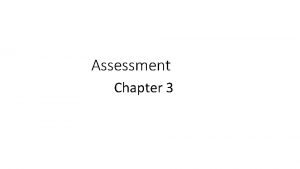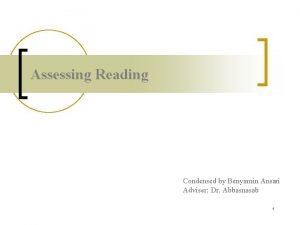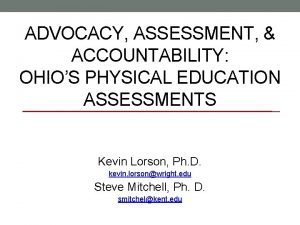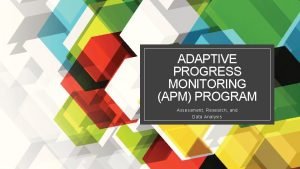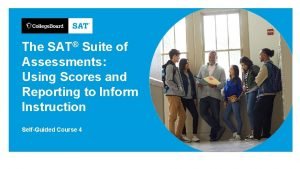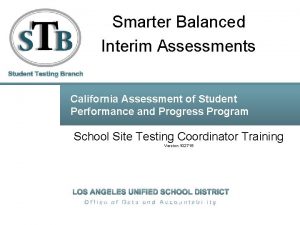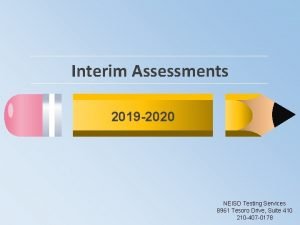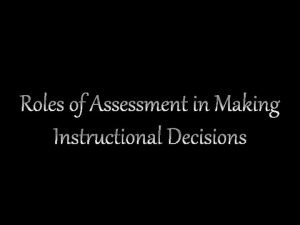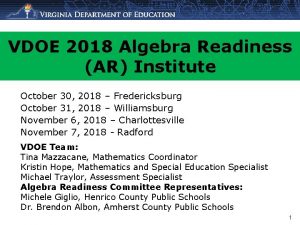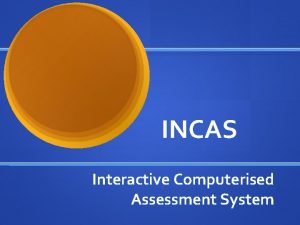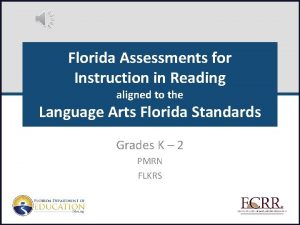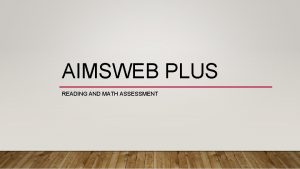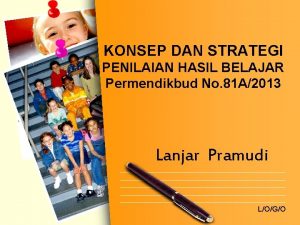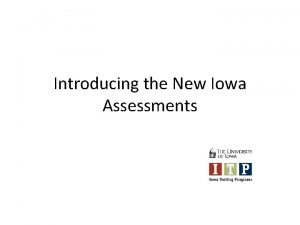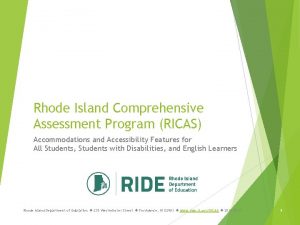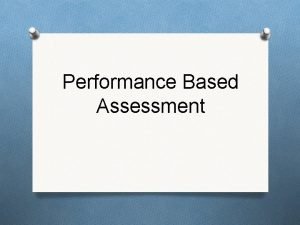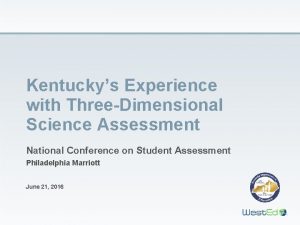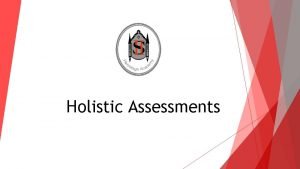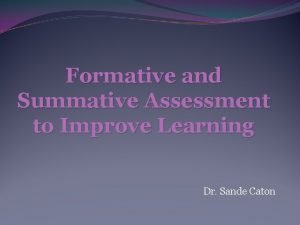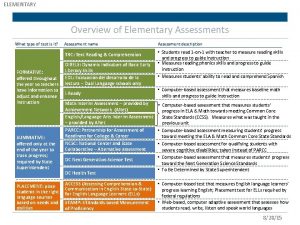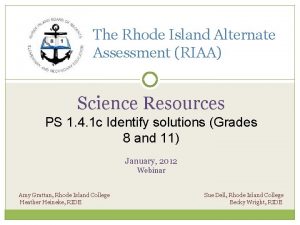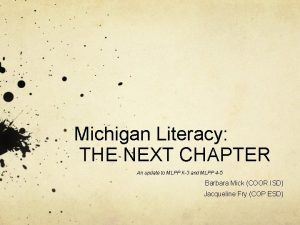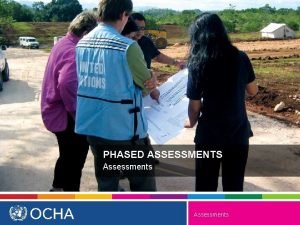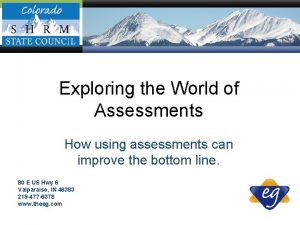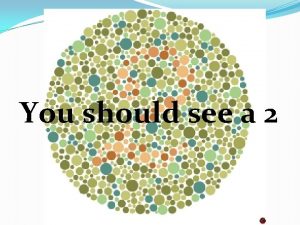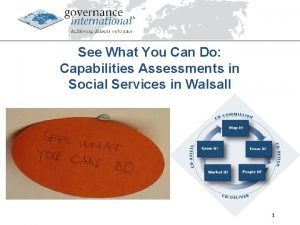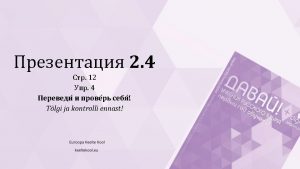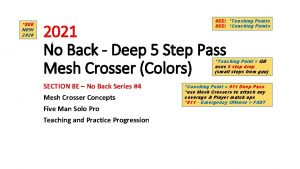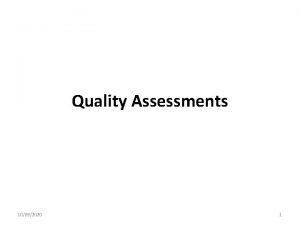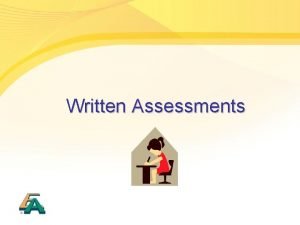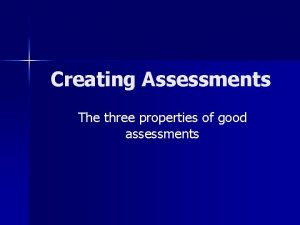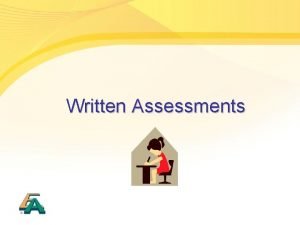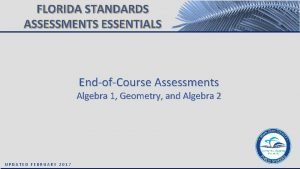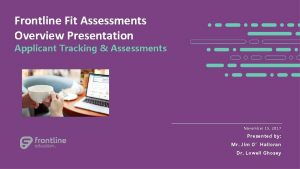Do You See What I See Using Assessments

















![What does developmentally-appropriate mean? [We want to use here Shutterstock picture 177145157] 18 What does developmentally-appropriate mean? [We want to use here Shutterstock picture 177145157] 18](https://slidetodoc.com/presentation_image_h2/5c55d042a68edb73c0579d42b56ed246/image-18.jpg)








































- Slides: 58

Do You See What I See? — Using Assessments to Guide Children’s Learning and Development

Learning Objectives: This training is designed to help you • Define observation-based assessment and understand its importance in promoting children’s development and learning; • Conduct effective observations and assess children throughout activities and routines within the daily schedule; • Gather useful assessment documentation in a way that is practical and easy; • Utilize documentation and assessment effectively to adjust curriculum, activities, and teaching strategies to promote children’s development and learning; and • Evaluate children’s progress with reliability. 2

Defining Observation-Based Assessment 3

Observation-Based Assessment How would you describe what “observation-based assessment” means? Please take a few minutes to reflect on as many words and phrases that come to mind! 4

Observation-Based Assessment • Observation-based assessment can be defined as watching and listening to individual and groups of children, as children interact with their surroundings and other people, with the clear goal of looking for specific behaviors or ability, to understand better what a child knows and can do. • Observation-based assessments document the actions and words observed. • Observation-based assessments should be ongoing throughout the year. • Observation-based assessment documentation provides the basis for future planning of activities and supports for individuals and groups of children. 5

Assessment of Typical versus Atypical Development There are typical milestones of child development. However. . . • All children develop at different paces. • To support development, provide instruction at the level of each individual child, so that the instruction is at a level each child can understand. • Sometimes a child may need more support than other children need, and may even need additional support, from a specialist. • To ensure that all children succeed in social and educational setting, it is important to conduct observational assessments of the children in your care. 6

Teaching Strategies Assessment Cycle Observational assessment is a continuous cycle of • Learning • Measuring • Growing Teaching Strategies, “The Importance of the Assessment Cycle” 7

Teaching Strategies Assessment Cycle Step 1: • Conduct daily, ongoing observations of knowledge, skills, and behaviors-minimal or no intrusion to the children’s activity children’s with • Record clear observations • Learn what is unique and special about each child Teaching Strategies, “The Importance of the Assessment Cycle” 8

Teaching Strategies Assessment Cycle Step 2: • Knowing what a child can and cannot do helps you decide how much support the child needs • Use information gathered to decide when and how to target instruction and provide support what, • Use information gathered to scaffold each child’s learning appropriately Teaching Strategies, “The Importance of the Assessment Cycle” 9

Teaching Strategies Assessment Cycle Step 3: • Decide which indicators of best describe the child’s knowledge, skills, and behaviors • Determine the child’s level of development in relation to each learning objective Teaching Strategies, “The Importance of the Assessment Cycle” 10

Teaching Strategies Assessment Cycle Step 4: • Summarize findings about each child • Intentionally develop plans for scaffolding, for individual children as well as the group • Communicate what you observed and strategies for supporting children’s growth to families and administrators Teaching Strategies, “The Importance of the Assessment Cycle” 11

TS GOLD Areas of Development and Learning Areas of Learning of the TS GOLD Objectives: Social-Emotional Cognitive Science & Technology Physical Literacy Social Studies Language Mathematics The Arts 12

Objectives for Development and Learning: Social-Emotional Domain 1. Regulates own emotions and behaviors a. Manages feelings c. Takes care of own needs appropriately b. Follows limits and expectations 2. Establishes and sustains positive relationships a. Forms relationships with adults d. Makes friends b. Responds to emotional cues e. Participates cooperatively and constructively in group situations (etc. ) c. Interacts with peers 13

TS GOLD Color Bands 14

Practice applying the TS GOLD Color Bands: Objective 1 Regulates own emotions and behaviors a. Manages feelings 15

Practice applying the TS GOLD Color Bands: Objective 14 Uses symbols and images to represent something not present a. Thinks symbolically 16

Ages & Stages of Development 17
![What does developmentallyappropriate mean We want to use here Shutterstock picture 177145157 18 What does developmentally-appropriate mean? [We want to use here Shutterstock picture 177145157] 18](https://slidetodoc.com/presentation_image_h2/5c55d042a68edb73c0579d42b56ed246/image-18.jpg)
What does developmentally-appropriate mean? [We want to use here Shutterstock picture 177145157] 18

TS GOLD Objective 11 Demonstrates positive approaches to learning d. Shows curiosity and motivation 19

Let’s Practice: Appropriate developmental expectations Answer choices: • Birth to 1 year • 1 to 2 years • 2 to 3 years • 3 to 4 years • 4 to 5 years 20

Appropriate developmental expectations: In what age range is it appropriate first to expect children to: • Hold a rattle and shake it? Birth to 1 year • Repeat simple phrases from familiar stories, such as “Chicka, Boom!” 2 to 3 years • Point to pictures in a book? 1 to 2 years • Feed self with finger foods such as Cheerios? Birth to 1 year 21

Appropriate developmental expectations: • Sit and remain engaged during storytime, despite interruptions? 4 to 5 years • Recognize and respond to feelings of others, by saying things like, “She crying”? 2 to 3 years • With the guidance of a teacher, can wait for a turn with a toy? 3 to 4 years • Express preferences for food or favorite toys by making sounds and facial expressions? Birth to 1 year 22

Appropriate developmental expectations: • Identify some of the letters in their names? 3 to 4 years • Name “how many” after counting up to three blocks? 2 to 3 years • Respond with facial expressions when someone calls her name? Birth to 1 year • Roll balls and watch how they move? 1 to 2 years • Sit for a teacher-led group time up to 15 minutes? 4 to 5 years 23

Practice assessing sample observation documentation: taken from wildflowerramblings. com 24

Practice assessing sample observation documentation: 25

Practice assessing sample observation documentation: 26

Louisiana’s Early Learning & Development Standards Louisiana Believes website (lousianabelieves. com): Louisiana’s Birth to Five Early Learning & Development Standards (ELDS) 27

Louisiana’s Early Learning & Development Standards 28

Louisiana’s Early Learning & Development Standards 29

Available early childhood developmental supports: Mental Health Consultation: Supports social and emotional development of young children https: //medicine. tulane. edu/departments/clinical-sciences/psychiatry/research/tikes Louisiana Early. Steps: Provides support for children birth to 36 months with a developmental delay or medical condition likely to result in developmental delay http: //ldh. la. gov/index. cfm/page/139/n/139 Pupil Appraisal: Provides support for children age 3 and older with developmental delays, learning problems, behavioral challenges, or other special needs [contact your parish school system office] 30

Techniques for Conducting Observations 31

Taking quality observational notes: Avoid descriptive language Be concise Avoid emotional language Write what you actually see 32

Taking quality observational notes: Be FACTUAL— Who? (child’s name) Write only what you SEE and HEAR— Where? AVOID “Why? ” When? What happened? 33

Taking quality observational notes: an example Date: 5/1/19 Location: writing center Note: James and Doug write next to ea other. J said, “D, you have a lot of words that rhyme with you. —pan, man, can, ran. I’m writing them. ” J clear speech, J holds pencil w/3 fingers in middle [TS GOLD Objectives 7 b, 9 c, 15 a, 19 b] 34

Taking quality observational notes: Video https: //www. youtube. com/watch? v=42 Af. HO 9 F 9 Eg 35

Materials for documenting observations • Note pads • Sticky notes • File folders on walls • Clip boards • Dry-erase boards • Plastic folders • Photographs (of children independently or together meeting objectives, of child samples such as artwork) • Videos • Voice/Audio recordings 36

Sample Documentation Strategy taken from Arielle Harvey on pinterest. com 37

Sample Documentation Strategy taken from scholastic. com Beth Newingham’s Teacher Blog on “Assessment in My Reading Workshop 38

Making a plan for observation and documentation: 39

Collecting documentation routinely: In order to assess children ACCURATELY, it is very important to collect observational data ROUTINELY: • in different situations • throughout the day • over time One observation might not be typical or representative of a child’s behavior or ability. Ongoing observations help you to detect PATTERNS in a child’s behavior, which are more accurate indicators of a child’s behavior or ability. 40

Collecting documentation throughout the day: • What might be captured during mealtimes? • What might be captured during transitions? • What might be captured in center time? • What might be captured in outdoor time? • What might be captured in small group time? • What might be captured in whole group time? 41

Collecting observations safely: Make sure there is never a break in the supervision of your children--to conduct observations safely use: • Sticky notes / a notepad / a clipboard near you → jot a quick note, while repeatedly looking up and scanning the play area; expand on the note later • Photos → document actions quickly in the moment, using the photo as a prompt for taking a note safely later Naptime is a useful time to write or expand on notes and to analyze and evaluate observational notes…. but remember you still must be able to see every child, gauge whether every child’s chest is rising and falling, and be able to respond immediately to the children! 42

Collecting observations appropriately: 43

Conducting observations: 44

Using Curriculum & Supplemental Activities for Assessment and Differentiation 45

Why Tier 1 curriculum supports children’s development: Each Tier 1 curriculum offers guidance and tools for assessing children’s growth and learning. You can use this assessment information to collect evidence of and monitor children’s progress. Each of the Tier 1 curriculum assessments are • consistent with the Louisiana Birth to Five Early Learning and Development Standards and with the TS GOLD Objectives for Development and Learning • conducted through a variety of methods such as anecdotal observations/notes, checklists, photographs, work samples, benchmark assessments, rubrics, etc. • embedded throughout activities and routines within the daily schedule (whole group, small group, center times, outdoor times, transitions, etc. ) 46

How to use Tier 1 curriculum assessment: • Become familiar with the new curriculum assessments (for example, what skills are assessed and how often they are assessed) • Before teaching, review the skills covered in the daily and weekly lesson plans • Plan for when, where, which children and what sills or objectives will be assessed each day of the week • Use the activities and assessments included in the curriculum to collect information on children’s knowledge and skills • reflect on children’s progress and use assessment information to make adaptations or accommodations to support the learning of every child 47

Additional Observation Tools/Methods: Creative Curriculum 48

Additional Observation Tools/Methods: Frog Street 49

Additional Observation Tools/Methods: TS GOLD “On the Spot” 50

Evaluating Development with Reliability 51

Objectivity vs. Subjectivity Facts vs. Assumptions: • Facts are things that you see and hear. • Assumptions are your personal opinions. When looking at behavior vs. interpretation of behavior, remember the difference between facts and assumptions: • Behavior is the way that someone acts in response to others and situations. (facts) • Interpretation of behavior is someone’s personal opinion of another’s behavior. (assumptions) 52

Objectivity vs. Subjectivity Facts vs. Assumptions: “Amelia did not share with Jacob when he asked to see her toy. ” vs. “Amelia has difficulty sharing. ” 53

Objectivity vs. Subjectivity “Tyler was playing with the music blocks. When Carly and Josh ask to play, Tyler agreed by saying ‘yes’ and showing them how. ” vs. “Tyler is a nice boy and gets along well with the other children. ” 54

Additional Assessment Reliability Tool Free, online TS GOLD Inter-Rater Reliability testing: https: //my. teachingstrategies. com/irr/status/ Free, online additional TS GOLD resources: https: //mypd. teachingstrategies. com/ 55

Last Thoughts As an additional possible follow-up to this training, look for a training that helps you support the children in your care further by helping you to practice differentiating activities to scaffold learning and development!

Key Knowledge Gained! 57

Please complete the Post-Assessment Evaluation Thank you! 58
 It's not what you look at that matters, it's what you see.
It's not what you look at that matters, it's what you see. Major prophets
Major prophets Good morning nice to see you
Good morning nice to see you Hello good afternoon teacher
Hello good afternoon teacher Observatieplan stappen
Observatieplan stappen General revision of assessments and property classification
General revision of assessments and property classification Performance assessments examples
Performance assessments examples Premarital tests or assessments
Premarital tests or assessments Common formative assessment examples
Common formative assessment examples Product-oriented rubric sample
Product-oriented rubric sample Mlpp assessments
Mlpp assessments 6 assessments for dols
6 assessments for dols Nebraska reads approved assessments
Nebraska reads approved assessments Strengths and weaknesses of informal assessments
Strengths and weaknesses of informal assessments Eccentric viewing techniques occupational therapy
Eccentric viewing techniques occupational therapy What are the elpac levels
What are the elpac levels Cte technical skills assessments.azed.gov/student
Cte technical skills assessments.azed.gov/student Creative arts grade 8 term 2 test
Creative arts grade 8 term 2 test Common core formative assessments
Common core formative assessments Traditional assessment definition
Traditional assessment definition Formal and informal assessment
Formal and informal assessment Characteristics of psychological assessment
Characteristics of psychological assessment Reading assessment examples
Reading assessment examples Physical education assessments examples
Physical education assessments examples Fsa assessments org apm
Fsa assessments org apm Sat subscores
Sat subscores Lausd interim assessments
Lausd interim assessments Staar interim assessments 2019-2020
Staar interim assessments 2019-2020 Characteristics of formative assessment
Characteristics of formative assessment Writing analytical assessments in social work
Writing analytical assessments in social work Vdoe algebra readiness
Vdoe algebra readiness Informative assessments
Informative assessments Incas testing
Incas testing What is physical fitness test in mapeh
What is physical fitness test in mapeh Florida assessment for instruction in reading
Florida assessment for instruction in reading Ddi assessments
Ddi assessments Aimsweb math benchmarks
Aimsweb math benchmarks Assessments strategies
Assessments strategies Iowa state assessments
Iowa state assessments Glba risk assessment requirements
Glba risk assessment requirements Outmatch assessments
Outmatch assessments Ricas english language arts
Ricas english language arts Types of performance based assessment
Types of performance based assessment Osde assessments
Osde assessments Next generation assessments examples
Next generation assessments examples Kentucky assessments science
Kentucky assessments science Characteristics of holistic assessment
Characteristics of holistic assessment اختبار تحصيلي
اختبار تحصيلي Anet interim assessments
Anet interim assessments Rhode island comprehensive assessments system
Rhode island comprehensive assessments system Mlpp assessments
Mlpp assessments Common core ela assessments
Common core ela assessments Www.fors-online.org.uk
Www.fors-online.org.uk Datarich student assessments
Datarich student assessments Adult assessment
Adult assessment System.collections.generics
System.collections.generics Dtfd switch
Dtfd switch You say that you love rain
You say that you love rain You are what you eat do you agree or disagree
You are what you eat do you agree or disagree
